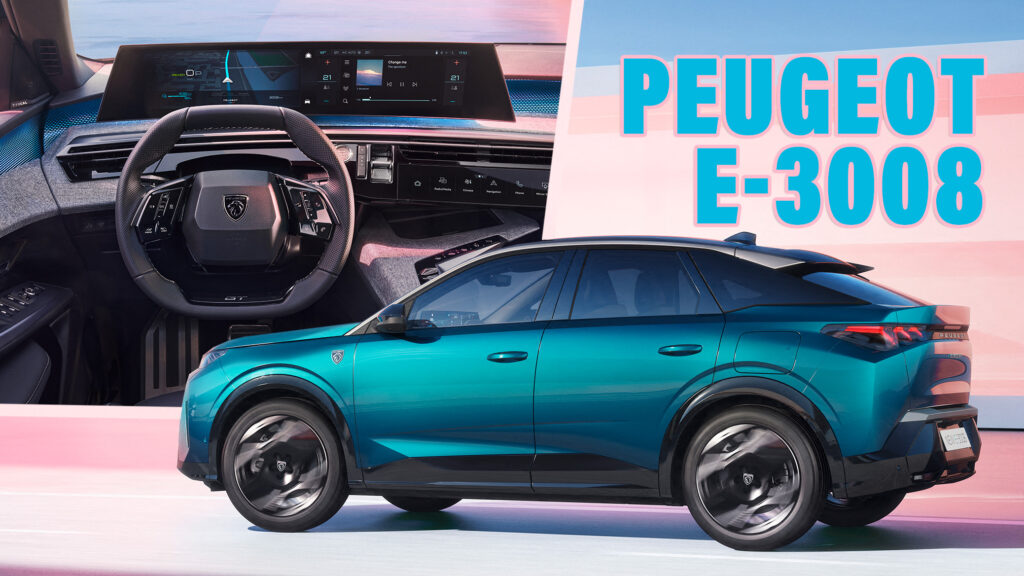First Stellantis product to to get the group’s new STLA Medium platform offers up to 316 hp and 435 miles of electric range
2 hours ago
 –>
–> 
–>
If you’re thinking we doubled-up on a post because Peugeot revealed the new E-3008 last week, then you’re half right. Following a leak that gave us a sneaky early look at the new crossover-coupe, Peugeot decided to release a handful of high-resolution images, but kept most of the mechanical details (plus a load more images) under wraps until today’s official launch.
So even if you read last week’s story, and even if you live in North America, where Peugeot has no presence, it’s worth sticking around. Because there’s more to learn about the E-3008, and this story is much bigger than one car. It’s about the future of Stellantis, because the E-3008 is the first vehicle to use the group’s new STLA Medium architecture, a platform that will be rolled out to other European and American brands. When Chrysler finally gets an EV to market two or three years from now, for instance, the E-3008’s platform is the one it’ll use.
Built for marathons, not sprints
advertisement scroll to continue
We already knew that the E-3008 would deliver ‘up to’ 316 hp (240 kW / 320 PS) and a maximum of 435 miles (700 km), but now we have all the other details to help fill in the blanks. So starting at the bottom of the three-model lineup, there’s the Electric 210. It features a single, front-mounted electric motor that pushes out 207 hp (157 kW / 210 PS) and 253 lb-ft (343 Nm), needs a fairly leisurely 8.7 seconds to reach 62 mph (100 km/h), and can travel for 326 miles (525 km) on its 73 kWh battery.
For drivers who need more there’s the Electric 230 Long Range. It also runs a single motor up front but gets a battery bump to 98 kWh, extending the distance between top-ups to 435 miles (700 km). There’s more power, too, output swelling to 227 hp (170 kW / 230 PS), though the extra curb weight (2,174 kg / 4,793 lbs vs 2,114 kg / 4,661 lbs) and identical torque figure means it’s even slower from the lights than the Electric 210 base model. It needs 8.9 seconds to hit 62 mph.
Related: This Is The New 2024 Peugeot E-3008 Electric Coupe-SUV
Buyers looking for more zip will want to check out the Electric 320. That takes the basic FWD 210 package and adds a 109 hp (80 kW / 110 PS), 122 lb-ft (166 Nm) rear-axle motor that makes this the only all-wheel drive E-3008. As the name suggests, the range-topper has 320 PS (240 kW / 316 hp), though it’s still no missile: zero to 62 takes 6.4 seconds. Surprisingly, Peugeot says the AWD 320 will have the the same 326-mile WLTP rating as the base car whose battery it shares, despite weighing 85 kg (187 lbs) more, because in those specific test conditions the extra mass has no impact. But we’ll be surprised if the two perform identically in the real world.
Hybrids and PHEVs come later
All three versions of the SUV get a 11 kW on-board charger as standard, with a 22 kW upgrade available as an option, and can accept 160 kW of AC power. That’s enough to charge the two standard range cars from 20-80 percent in 30 minutes, while the 230 Long Range model needs five fewer minutes because it will join the lineup a little later and have a different battery technology. Too impatient to wait that half an hour to juice-up mid-journey? Then you’ll be interested to know that the Stellantis STLA Medium platform also accommodates hybrid and plug-in hybrid powertrains and Peugeot will be introducing those in a plain (non-E) 3008.
We’ve already talked about the styling in our previous post, and besides, you don’t need us to walk you around the car when you can see it for yourself and make your own mind up about the design. It’s a fastback SUV that adopts the muscular design language of cars like the new 4008, and features a far sportier roofline than the outgoing 3008.
That roofline doesn’t impact on the seats-up, fill-to-window-line cargo volume, which at 520 liters (18.4 cu-ft) matches what the 3008 can deliver. But it might be a different story with the seats down; Peugeot isn’t saying. It’s also worth noting that the all-wheel driver model’s rear motor robs 50 liters (1.8 cu-ft) of stowage space, and that none of the cars has a frunk.
All-new Panoramic i-Cockpit interior
Where the new platform should deliver more practicality, is inside. The E-3008’s 2,739 mm (107.8-inch) wheelbase is 64 mm (2.5-inches) bigger than the old 3008’s, which ought to give rear-seat passengers a noticeable increase in rear legroom. And if front passengers don’t get to share in the legroom spoils they do at least get to play with Peugeot’s new 21-inch, curved Panoramic i-Cockpit display.
The E-3008 goes on sale in Europe in February 2024, the first models to arrive being the base FWD 210 and a petrol hybrid that we’re still waiting for official details of. The remaining BEVs and a PHEV will join the range by the end of Q3, 2024. And with that spread of powertrains, distinctive styling and another bold interior, we’ve no doubt that the E-3008 and 3008 are destined to become big hits for Peugeot, particularly given the success of its other SUVs and EVs.
But as we’ve mentioned already, this story is about more than one car. We’ll be seeing a lot more of the STLA Medium platform in the years to come.

 <!–
<!– –>
–>